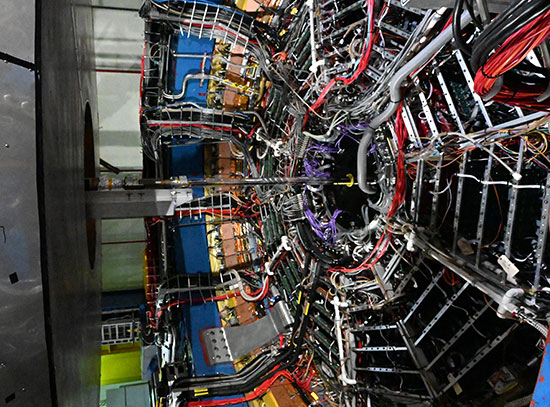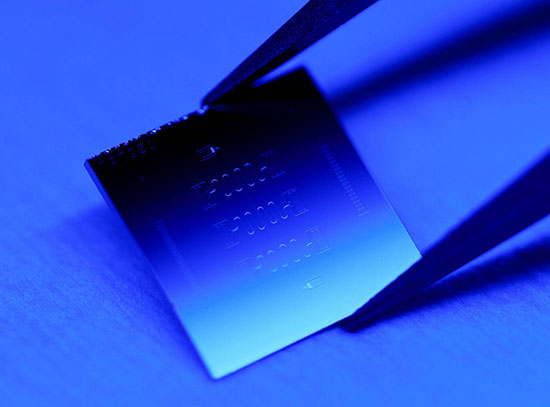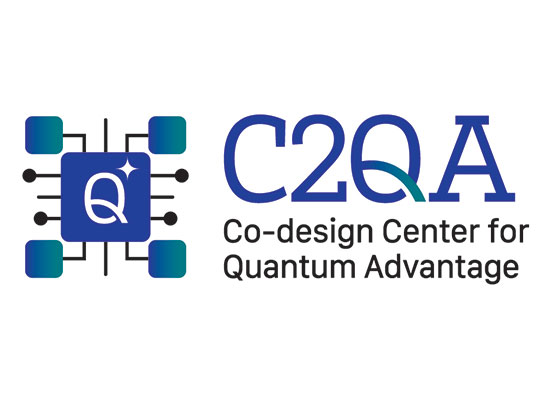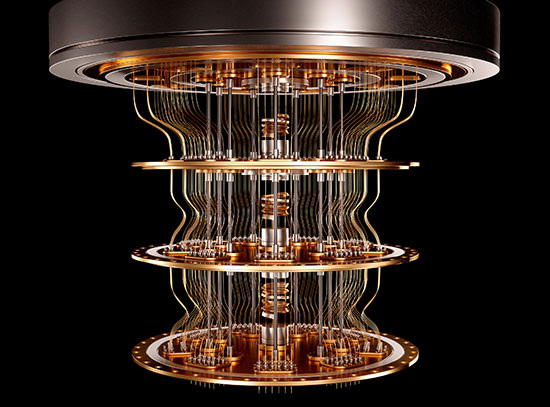Energy Secretary Chris Wright Visits Brookhaven National Laboratory
Secretary Wright tours site of America's next collider, launches entangled photons, watches a "quantum press," and sees tools used to improve batteries and gas-to-liquid fuel conversion, all accelerated by AI
September 30, 2025
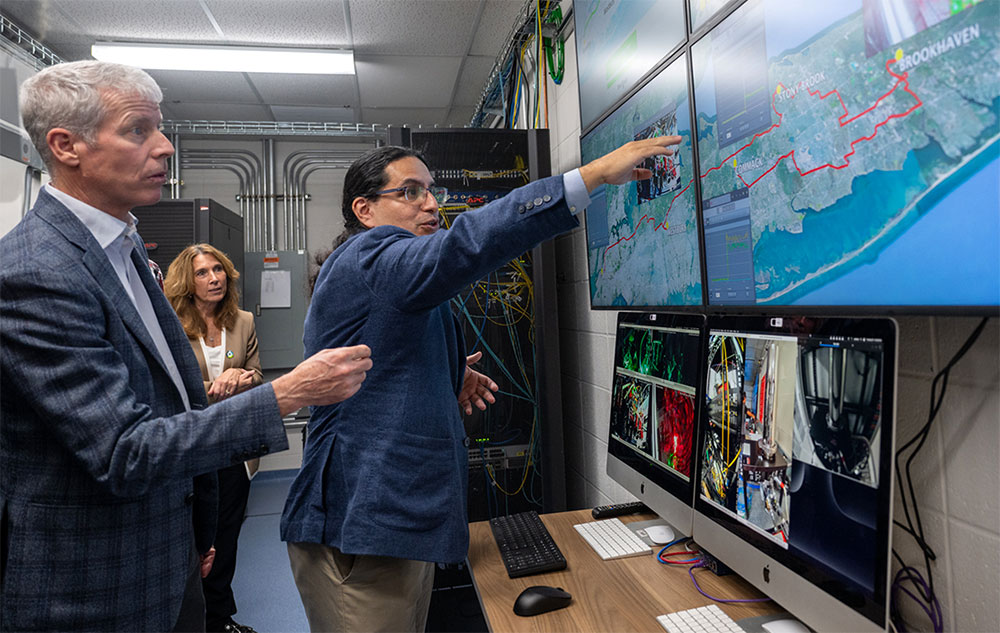 enlarge
enlarge
U.S. Secretary of Energy Chris Wright (left), Brookhaven Lab Deputy Director for Operations Ann Emrick, and quantum scientist Eden Figueroa track light particles traveling along the nation's longest fiber-optic quantum network. (Kevin Coughlin/Brookhaven National Laboratory)
UPTON, N.Y. — U.S. Energy Secretary Chris Wright took a behind-the-scenes tour of cutting-edge science and technology facilities at the U.S. Department of Energy’s (DOE) Brookhaven National Laboratory on Tuesday, Sept. 30. The tour included stops at:
- The Relativistic Heavy Ion Collider (RHIC), the nation’s only particle collider, which will soon be transformed into the world’s only Electron-Ion Collider (EIC), designed to provide the first-ever movies of what goes on inside the protons and neutrons that make up everyday matter
- The launch pad for particles of light traversing the longest fiber-optic quantum communications network in the U.S.
- X-ray beamlines for studies of materials used in batteries, catalysts, and other energy applications that will allow scientists to unlock their full potential
- The Brookhaven Lab Quantum Material Press, a first-of-its-kind experimental tool that enables automated synthesis of materials for quantum information science
“It was great to see how Brookhaven’s scientists, engineers, technicians, and staff embody America’s ingenuity as they explore new frontiers in nuclear physics and quantum networking to improve the materials we need to unleash American energy dominance,” said Wright. “The research that takes place at this Laboratory, including at the user facilities it operates for all U.S. scientists, helps keep DOE and our nation at the forefront of discovery science.”
Accelerating pathways to discovery
 enlarge
enlarge
Brookhaven Lab Interim Director John Hill (left) welcomes Secretary Wright. (Kevin Coughlin/Brookhaven National Laboratory)
Secretary Wright first met with Brookhaven Lab leaders in the Lab’s just-opened Science and User Support Center, the gateway for thousands of scientists, facility users, students, and other guests who visit the Lab each year. John Hill, Brookhaven’s interim director, and others described the Lab’s overall mission to accelerate pathways to scientific discovery and technological innovation that transform the world.
“We’re so grateful that Secretary Wright could join us to see some of the amazing science that the Department of Energy enables every day here at Brookhaven Lab,” said Hill. “It was a pleasure to show him around and share with him the pride and dedication our staff have for their work and our mission.”
Next, the Secretary toured two of 29 research stations, known as beamlines, at the National Synchrotron Light Source II (NSLS-II), where scientists use the facility’s intense X-rays to see atomic-level structures and monitor chemical changes in materials in real time. He learned how artificial intelligence (AI) is speeding the pace of discovery to improve materials used in batteries, transistors, and the catalysts that power energy conversions — including the transformation of natural gas into easily transportable liquid fuel. He also signed a vacuum chamber to dedicate the most recently completed beamline, marking its entry into the Lab’s and DOE’s mission of unlocking the full potential of America’s energy resources.
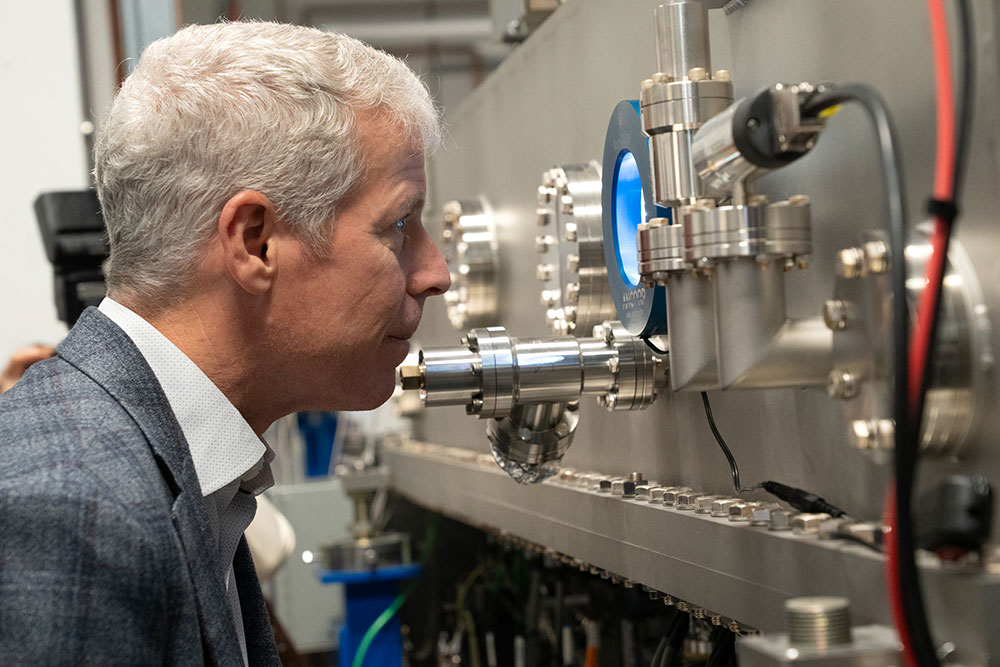 enlarge
enlarge
Secretary Wright visits the Coherent Diffractive Imaging (CDI) beamline at the National Synchrotron Light Source II. (David Rahner/Brookhaven National Laboratory)
America’s next collider
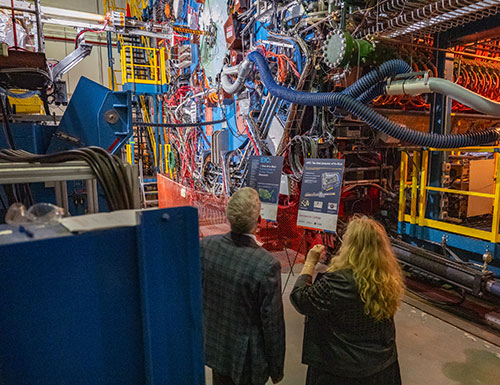 enlarge
enlarge
Secretary Wright (left) and Elke-Caroline Aschenauer, Electron-Ion Collider co-associate director for experimental program during a tour stop at the STAR detector at the Relativistic Heavy Ion Collider. (Kevin Coughlin/Brookhaven National Laboratory)
Secretary Wright then visited Brookhaven Lab’s Collider Center for a briefing on the cutting-edge science that will take place at the Electron-Ion Collider (EIC), the only new collider scheduled to be built anywhere in the world over the next decade. He descended into the tunnel of the Relativistic Heavy Ion Collider (RHIC), where discoveries and advances in accelerator science and detector technology over the past 25 years have laid the scientific foundation and will provide crucial infrastructure for the EIC.
Inside the 2.4-mile-circumference tunnel, Wright followed the path of near-light-speed nuclear particles and viewed RHIC’s house-sized STAR detector, which scientists use to capture glimpses of collisions that recreate the matter that filled the early universe and explore the origins of proton spin. He learned how Brookhaven scientists and partners from across the DOE complex will soon begin work to add an electron ring and other new state-of-the-art accelerator and detector technologies to transform this groundbreaking facility into America’s next collider. At the EIC, speeding spin-aligned electrons will collide with polarized protons and nuclei to open a new frontier in nuclear physics, unlocking the secrets of the building blocks of everything we see in the universe today and the strongest force in nature.
“The EIC and its detector, known as ePIC, will propel America’s leadership in technological innovation and fundamental scientific understanding for decades to come,” said Brookhaven Lab’s Daniel Marx, an accelerator physicist helping to build the EIC who is looking forward to its discoveries about the fundamental structure of matter.
See more photos from the visit. Hover over image to reveal slideshow controls.
The future of computing, quantum, and AI
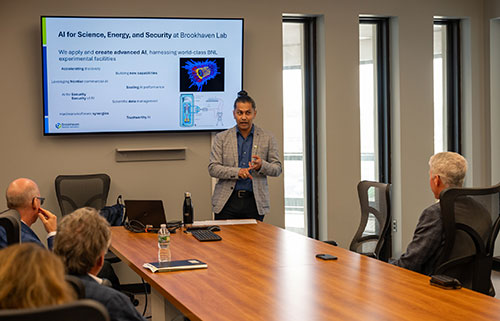 enlarge
enlarge
Carlos Soto, a group leader in the Computing and Data Sciences directorate, explains how artificial intelligence is used for science, energy, and security at Brookhaven Lab. (Kevin Coughlin/Brookhaven National Laboratory)
After a lunch with early career Lab staff — where the Secretary learned about their contributions to fields including accelerator physics, energy systems engineering, and isotope production — Wright visited the Lab’s Computing and Data Sciences directorate. He witnessed how state-of-the-art technologies compile one of the largest archives of scientific data in the world — over 500 petabytes, equivalent to 370 million Netflix movies — and provide remote access to that data for collaborators across the nation and around the world. He also learned about Brookhaven Lab’s efforts in “embodied AI,” in which robots powered by AI learn by interacting with the physical world — as opposed to learning from internet data — to become significantly more adept at controlling real-world systems. Brookhaven Lab is leading the way in using such embodied AI to advance its own science.
Next, at the Lab’s Quantum Networking Facility, Wright launched particles of light on a record-breaking quantum journey, sending “entangled photons” from Brookhaven to Stony Brook University, New York City, and back. This feat employed the nation’s longest fiber-optic quantum network, where two particles of light traveling different routes along the 161-mile-long path maintain knowledge of one another even over vast distances. Achieving and maintaining such long-distance entanglement sets the stage for scalable quantum communication.
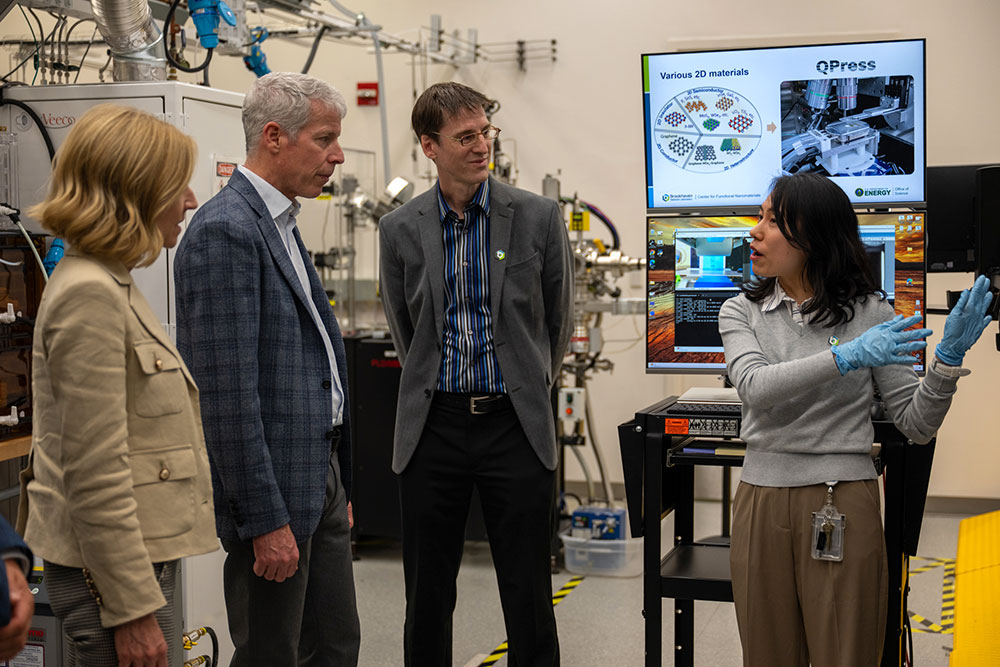 enlarge
enlarge
Liz Wright (left), Secretary Wright, Center for Functional Nanomaterials (CFN) Interim Director Kevin Yager, and CFN staff scientist Suji Park at the Quantum Material Press. (Kevin Coughlin/Brookhaven National Laboratory)
The Secretary then toured facilities in Brookhaven Lab’s Center for Functional Nanomaterials (CFN) that are used to make and characterize materials for applications ranging from advanced electronics to quantum information science. This included a stop at CFN’s world-leading Quantum Material Press, where scientists produce and layer atomically thin materials with desired properties to enable the quantum technologies of tomorrow.
Finally, Secretary Wright addressed all Brookhaven Lab employees during a live-streamed “fireside chat” hosted by Interim Director John Hill.
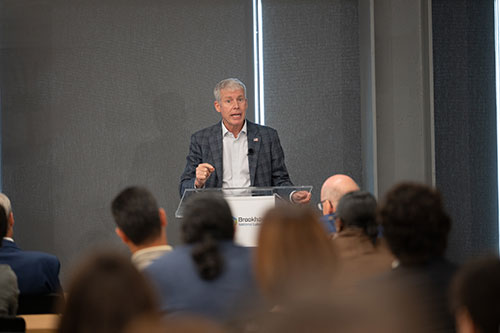 enlarge
enlarge
Secretary Wright addresses Brookhaven Lab staff. (Kevin Coughlin/Brookhaven National Laboratory)
“We would not live in a world recognizable to what we have today if not for the national labs,” Secretary Wright said. “There is a lot of flow between the labs that creates a healthy ecosystem for innovation; the labs are competitive to be the best but collaborative to bring the best science forward.”
Recapping what he saw at Brookhaven, he said, “I see great people who care about what they do.”
Brookhaven Lab’s scientific research is funded primarily by the DOE Office of Science. RHIC, NSLS-II, and CFN are DOE Office of Science user facilities.
Brookhaven National Laboratory is supported by the Office of Science of the U.S. Department of Energy. The Office of Science is the single largest supporter of basic research in the physical sciences in the United States and is working to address some of the most pressing challenges of our time. For more information, visit science.energy.gov.
Follow @BrookhavenLab on social media. Find us on Instagram, LinkedIn, X, and Facebook.
2025-22646 | INT/EXT | Newsroom





